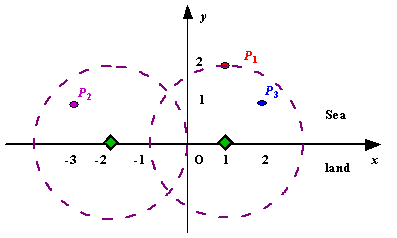Assume the coasting is an infinite straight line. Land is in one side of coasting, sea in the other. Each small island is a point locating in the sea side. And any radar installation, locating on the coasting, can only cover d distance, so an island in the sea can be covered by a radius installation, if the distance between them is at most d.
We use Cartesian coordinate system, defining the coasting is the x-axis. The sea side is above x-axis, and the land side below. Given the position of each island in the sea, and given the distance of the coverage of the radar installation, your task is to write a program to find the minimal number of radar installations to cover all the islands. Note that the position of an island is represented by its x-y coordinates.

Figure A Sample Input of Radar Installations
We use Cartesian coordinate system, defining the coasting is the x-axis. The sea side is above x-axis, and the land side below. Given the position of each island in the sea, and given the distance of the coverage of the radar installation, your task is to write a program to find the minimal number of radar installations to cover all the islands. Note that the position of an island is represented by its x-y coordinates.

Figure A Sample Input of Radar Installations
Input
The input consists of several test cases. The first line of each case contains two integers n (1<=n<=1000) and d, where n is the number of islands in the sea and d is the distance of coverage of the radar installation. This is followed by n lines each containing two integers representing the coordinate of the position of each island. Then a blank line follows to separate the cases.
The input is terminated by a line containing pair of zeros
The input is terminated by a line containing pair of zeros
Output
For each test case output one line consisting of the test case number followed by the minimal number of radar installations needed. "-1" installation means no solution for that case.
Sample Input
3 2 1 2 -3 1 2 1 1 2 0 2 0 0
Sample Output
Case 1: 2 Case 2: 1
海岛和雷达问题,看看怎样用最少的雷达覆盖所有海岛;
输入 3 2 是海岛数 和雷达覆盖半径;
接下来是 : 海岛坐标
我感觉这题好奇葩,测试数据都过了,就是提交不上,说明你还是有地方用了整形(%d),看看能换的全部用double 试试;
下面是我同学的代码……我的是数据都过 ……就是WA

1 #include <stdio.h> 2 #include<string.h> 3 #include<stdlib.h> 4 #include<math.h> 5 using namespace std; 6 struct node 7 { 8 double a,b; 9 }area[1005]; 10 int cmp(const void *a,const void *b) 11 { 12 return (*(node *)a).b>(*(node *)b).b?1:-1; 13 } 14 int main() 15 { 16 int n,i,sum,f,h=1; 17 double x,y,d,e; 18 while(~scanf("%d%lf",&n,&d)&&(n!=0||d!=0)) 19 { 20 f=0; sum=1; 21 for(i=0; i<n; i++) 22 { 23 scanf("%lf%lf",&x,&y); 24 area[i].a=x-sqrt(d*d-y*y);//这里是坐标转区间 25 area[i].b=x+sqrt(d*d-y*y); 26 if(y<0) 27 y=-y; 28 if(y>d) 29 f=1; 30 } 31 32 if(f) 33 printf("Case %d: -1 ",h); 34 35 else 36 { 37 qsort(area,n,sizeof(area[0]),cmp); 38 e=area[0].b; 39 for(i=1; i<n; i++) 40 { 41 if(area[i].a>e)//找左边界小于该右边界的 42 { 43 sum++; 44 e=area[i].b; 45 } 46 } 47 printf("Case %d: %d ",h,sum); 48 } 49 h++; 50 } 51 return 0; 52 }
